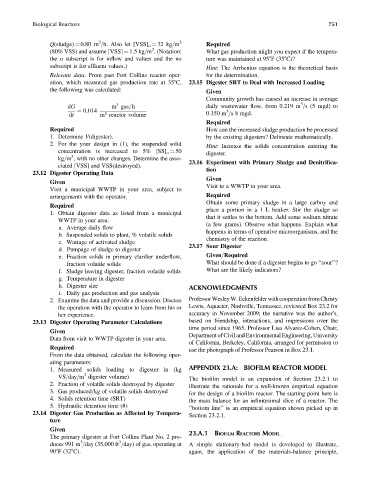Page 796 - Fundamentals of Water Treatment Unit Processes : Physical, Chemical, and Biological
P. 796
Biological Reactors 751
3
Q(sludge) ¼ 0.80 m =h. Also let [VSS] o ¼ 32 kg=m 3 Required
3
(80% VSS) and assume [VSS] ¼ 1.5 kg=m . (Notation: What gas production might you expect if the tempera-
the o subscript is for inflow and values and the no ture was maintained at 958F (358C)?
subscript is for effluent values.) Hint: The Arrhenius equation is the theoretical basis
Relevant data. From past Fort Collins reactor oper- for the determination.
ation, which measured gas production rate at 358C, 23.15 Digester SRT to Deal with Increased Loading
the following was calculated: Given
Community growth has caused an increase in average
3
3
dG m gas=h daily wastewater flow, from 0.219 m =s (5 mgd) to
¼ 0:014 3
3
dt m reactor volume 0.350 m =s 8 mgd.
Required
Required How can the increased sludge production be processed
1. Determine V(digester). by the existing digesters? Delineate mathematically.
2. For the your design in (1), the suspended solid Hint: Increase the solids concentration entering the
concentration is increased to 5% [SS] o ¼ 50 digester.
3
kg=m , with no other changes. Determine the asso-
23.16 Experiment with Primary Sludge and Denitrifica-
ciated [VSS] and VSS(destroyed).
tion
23.12 Digester Operating Data
Given
Given
Visit to a WWTP in your area.
Visit a municipal WWTP in your area, subject to
arrangements with the operator. Required
Obtain some primary sludge in a large carboy and
Required
place a portion in a 1 L beaker. Stir the sludge so
1. Obtain digester data as listed from a municipal
that it settles to the bottom. Add some sodium nitrate
WWTP in your area.
(a few grams). Observe what happens. Explain what
a. Average daily flow
happens in terms of operative microorganisms, and the
b. Suspended solids to plant, % volatile solids
chemistry of the reaction.
c. Wastage of activated sludge
23.17 Sour Digester
d. Pumpage of sludge to digester
e. Fraction solids in primary clarifier underflow, Given=Required
fraction volatile solids What should be done if a digester begins to go ‘‘sour’’?
f. Sludge leaving digester, fraction volatile solids What are the likely indicators?
g. Temperature in digester
h. Digester size ACKNOWLEDGMENTS
i. Daily gas production and gas analysis.
2. Examine the data and provide a discussion. Discuss Professor Wesley W.Eckenfelder withcooperation from Christy
the operation with the operator to learn from his or Lewis, Aquaeter, Nashville, Tennessee, reviewed Box 23.2 for
her experience. accuracy in November 2009; the narrative was the author’s,
23.13 Digester Operating Parameter Calculations based on friendship, interactions, and impressions over the
time period since 1965. Professor Lisa Alvarez-Cohen, Chair,
Given
Department of Civil and Environmental Engineering, University
Data from visit to WWTP digester in your area.
of California, Berkeley, California, arranged for permission to
Required
use the photograph of Professor Pearson in Box 23.1.
From the data obtained, calculate the following oper-
ating parameters:
1. Measured solids loading to digester in (kg APPENDIX 23.A: BIOFILM REACTOR MODEL
3
VS=day=m digester volume)
The biofilm model is an expansion of Section 23.2.1 to
2. Fraction of volatile solids destroyed by digester
illustrate the rationale for a well-known empirical equation
3. Gas produced=kg of volatile solids destroyed
for the design of a biofilm reactor. The starting point here is
4. Solids retention time (SRT) the mass balance for an infinitesimal slice of a reactor. The
5. Hydraulic detention time (u) ‘‘bottom line’’ is an empirical equation shown picked up in
23.14 Digester Gas Production as Affected by Tempera- Section 23.2.1.
ture
Given
23.A.1 BIOFILM REACTORS MODEL
The primary digester at Fort Collins Plant No. 2 pro-
3
3
duces 991 m =day (35,000 ft =day) of gas, operating at A simple stationary-bed model is developed to illustrate,
908F (328C). again, the application of the materials-balance principle,

